Maranta Leuconeura is also known as the prayer plant. These plants are Famous for folding leaves in the dark like praying hands. It’s a charming plant and not so horribly difficult to grow like some of its touchy relatives.
If you give the maranta prayer plant what it needs it will grow happily. Folding and moving its stunning leaves with the changing light in your home.
Those gorgeous moving leaves of maranta plants are the big draw. All the prayer plant varieties have impressive colors and veining. These plants are often also referred to as Cathedral windows, of the Herringbone plant.
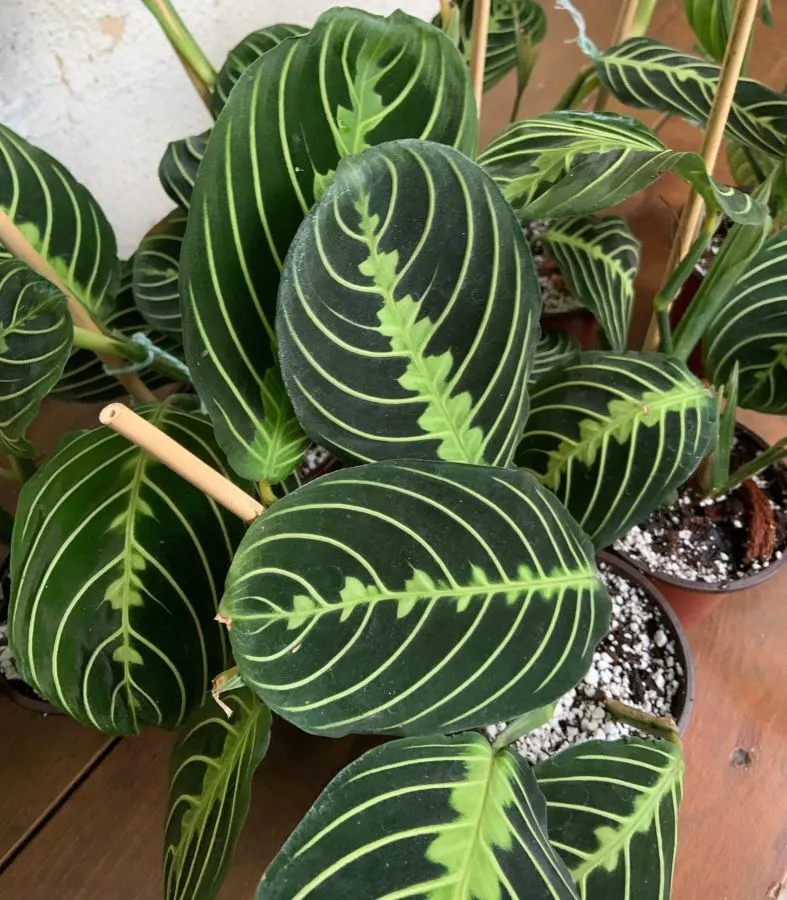
Marantas and Calatheas are both known as Prayer Plants. They are in the same plant family, Marantaceae. However, Plants in these two genus are often confused.
Maranta and Calatheas all grow in the tropical rainforests of Brazil. So their basic needs are very similar. And they all have reactive leaves.
But they are quite different in their types of growth and willingness to tolerate less than ideal conditions.
Most Calatheas are extremely sensitive to conditions and less able to adjust to improper care.
You can read how to care for the lovely but delicate Calatheas in this post.
The prayer plant varieties are sturdier than their fussy plant cousins. but they do need good care. Please read our care guide below thoroughly to learn how to get along well with your beautiful praying hands plant.
Prayer Plant Varieties:
Although many cultivars exist of the maranta genus only two varieties are usually found in your flower shops. They, in turn, have several colors.
Your prayer plant commonly flowers in the wild. It may even flower indoors. But that’s rare. And you won’t miss the flowers really.
Prayer plant flowers are small and understated. They are pictured below in the variety kerchoveana commonly known as Rabbit tracks or rabbit foot.
The two major varieties sold in the retail plant shops as Maranta leuconeura var. erythroneura and Maranta leuconeura var. kerchoveana.
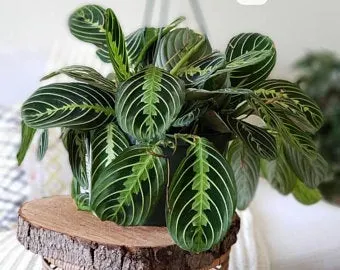
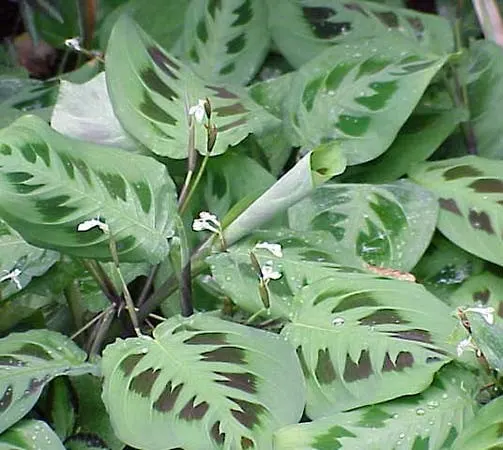
The erythroneura, or Herringbone plant, comes in three common colors lemon lime, the red Maranta Leuconeura is shown below with it’s red veining, and the silver band. There is also a black Maranta Leuconeura with smaller fuzzy leaves.
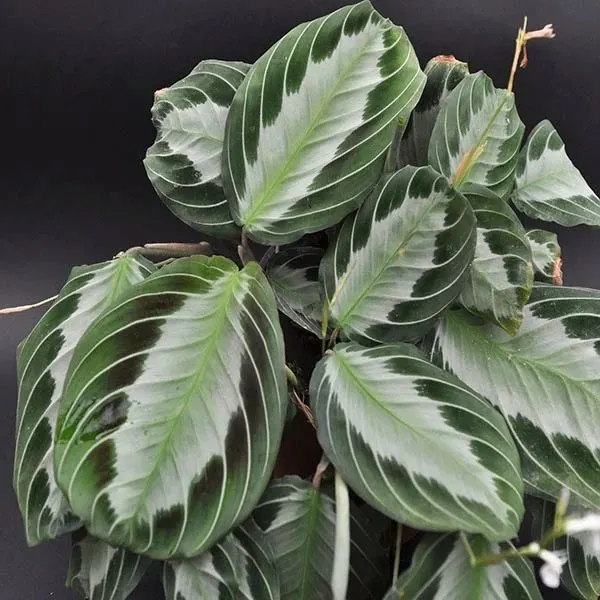

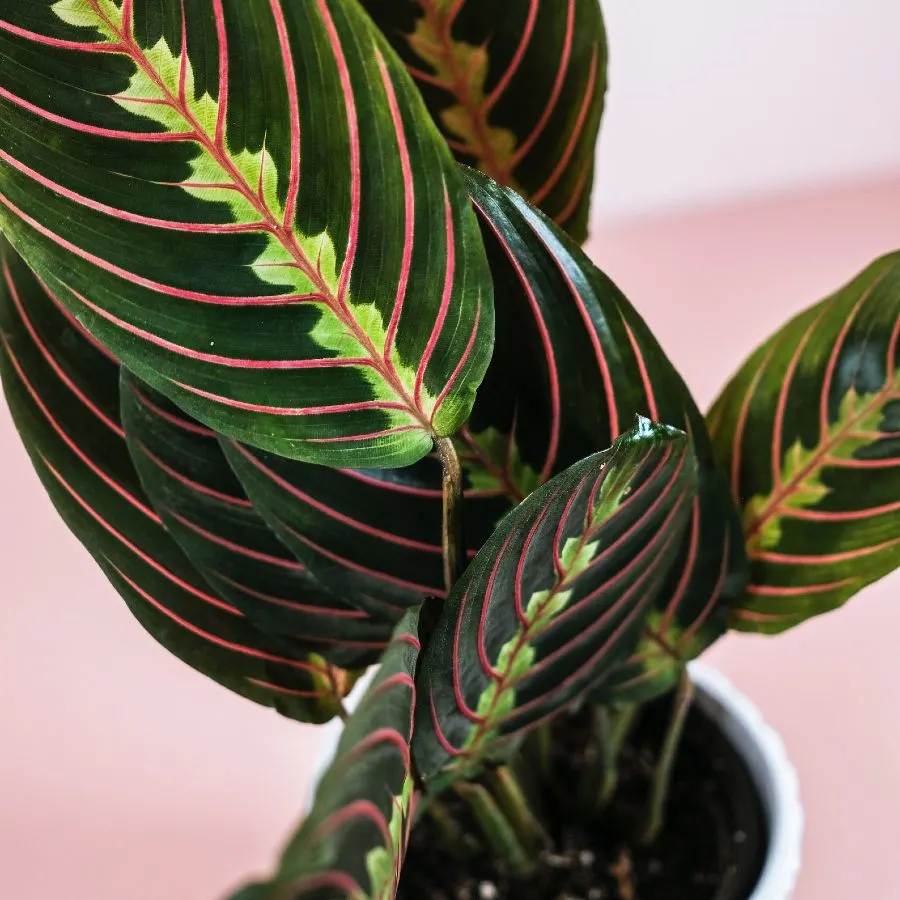
More varieties are showing up in garden shops all the time so keep your eyes open for new colors.
Purchase Prayer Plants from Etsy

How do prayer plants grow?
Maranta plants stay lower in height. This makes them wonderful on plant tables, and as center pieces. They make interesting focal points in a room when well placed.
When pruned, the plant will retain it’s upright bushy growth. If you want it to trail as pictured below, let it grow. Marantas make beautiful eyecatching hanging baskets. They also look good trailing off a table or shelf.
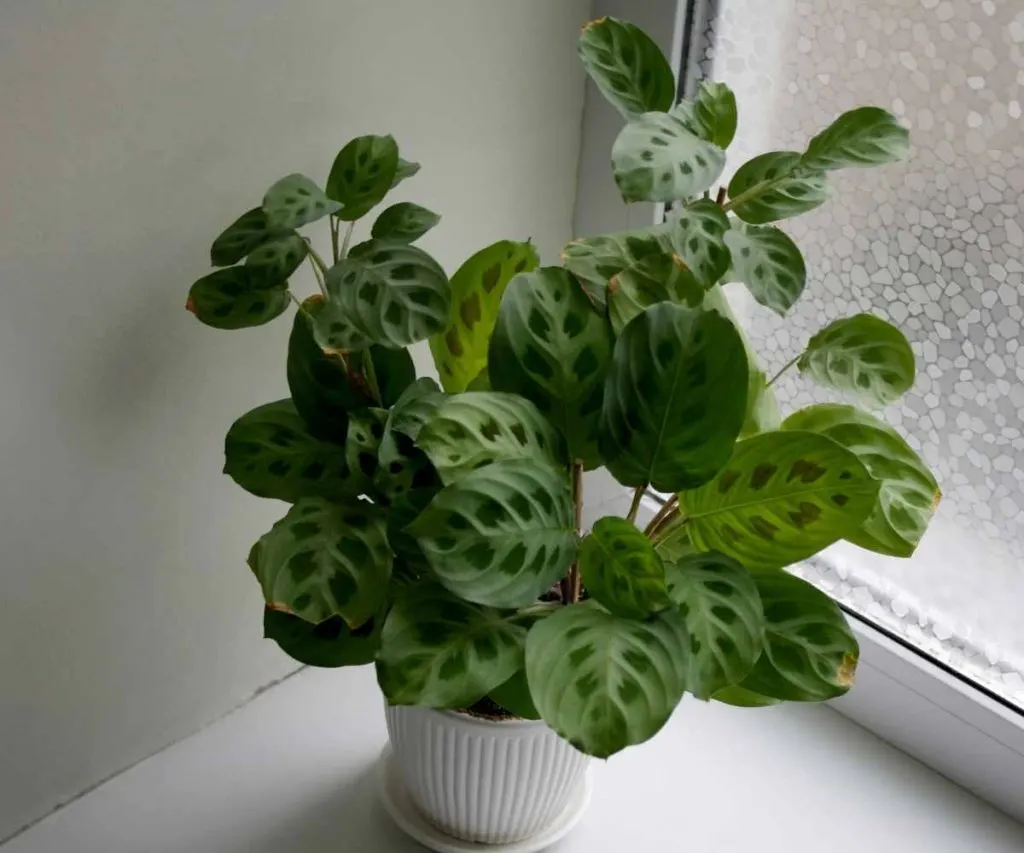
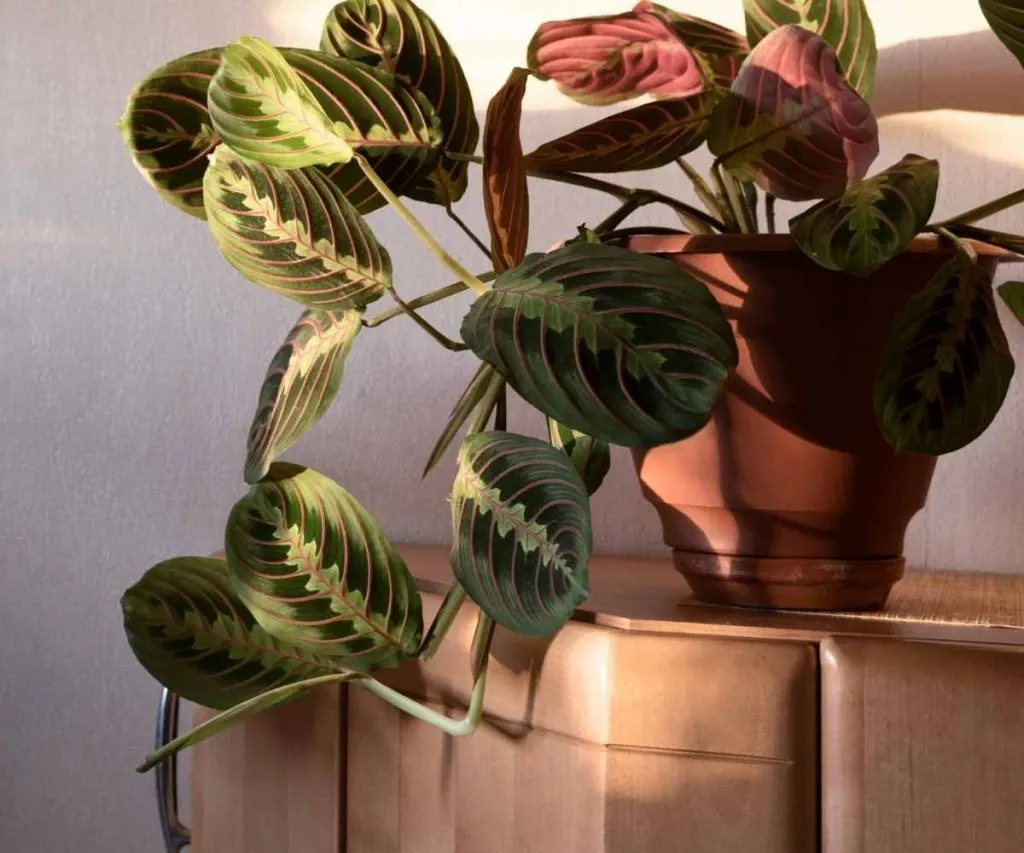
These plants are fascinating to own. With interesting foliage and lower light needs they can live in many places in your home and be quite content.
When you do prune these plants a clean pair of small pruners or sharp scissors is all you need. Prune off old dead leaves at the soil line to keep the plant pretty.
NonToxic Plant:
Bravo! ALL the maranta plants are non toxic to humans and pets. We don’t recommend allowing kids and pets to chew the foliage but if they do the leaves won’t harm them.
That said, it’s not a good idea to eat a houseplant. Even a non toxic one. They are not grown as food safe. You don’t know what pathogens, fungi, pests or chemicals may have attached themselves to the leaves and soil.
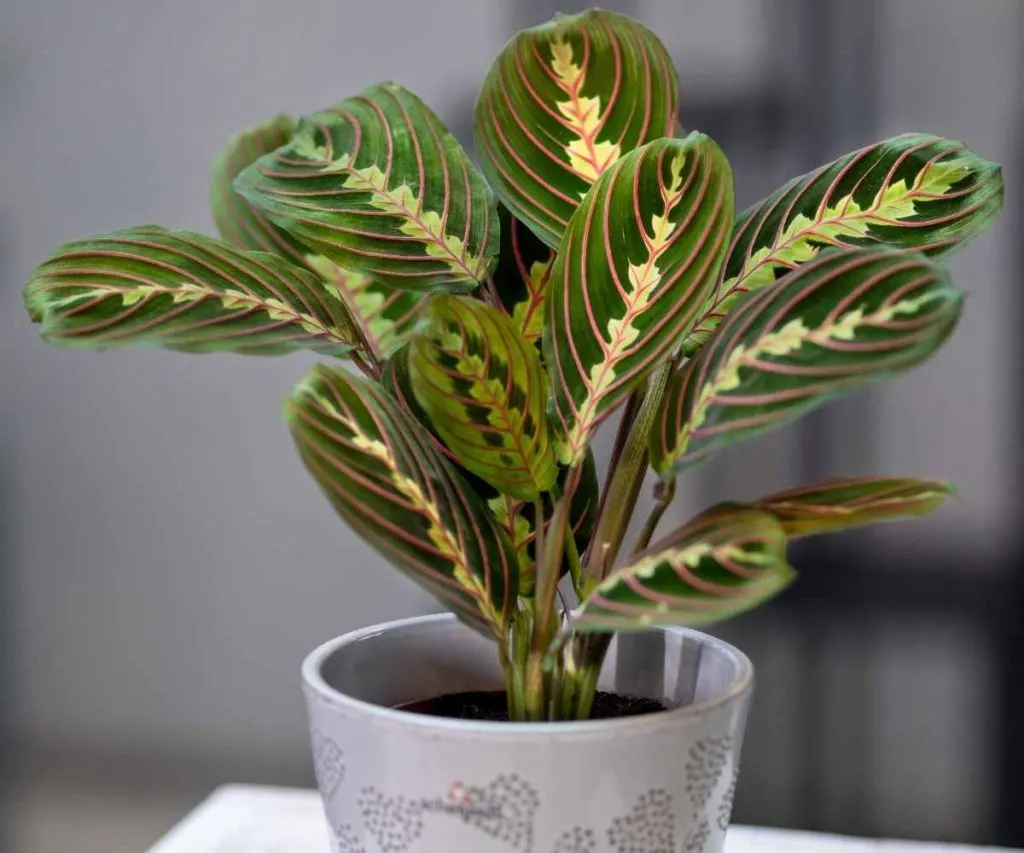
How to Care For a Prayer Plant:
Maranta plants grow on the ground under the tree canopy, love soft acid water and soils that are moist and very well draining. Offer them indirect rather than direct light.
They prefer moderate light intensity but will grow in lower light. Too bright light or too dark light will fade their leaves.
Prayer plant leaves curling? or does your Prayer plant yellow leaves? Read our complete care guide to find out how to give your plant the best care and avoid these problems and more.
Maranta (prayer plant) Care Guide
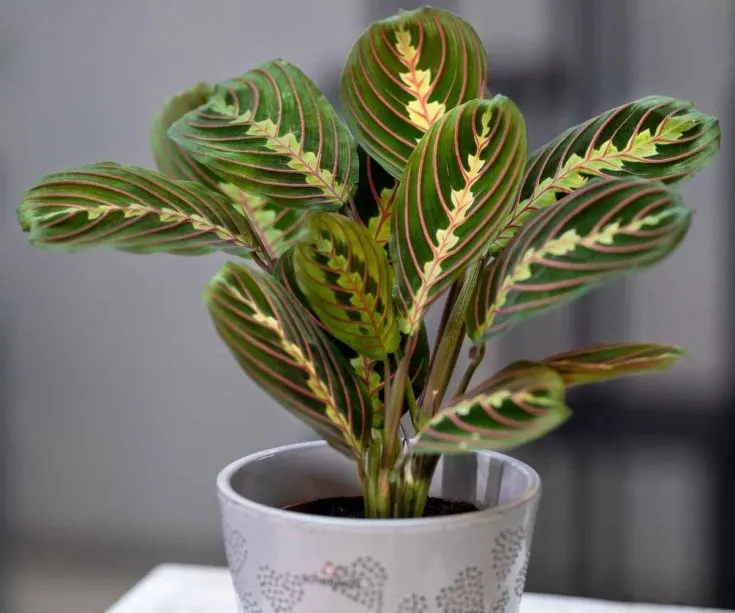
Maranta are beautiful, exotic plants with wide appeal. These plants are well known for their beautiful leaves that fold up straight after dark like praying hands.
Once you find the perfect growing conditions for your Maranta it will perform well for you.
Learn what they need and give it to them. Their lovely foliage (in some cases they even flower) are so worth the effort!
All Maranta plant care is similar. No matter what type you own this care guide will apply.
Materials
Instructions
Soil Preference:
- Marantas enjoy a light well draining soil.
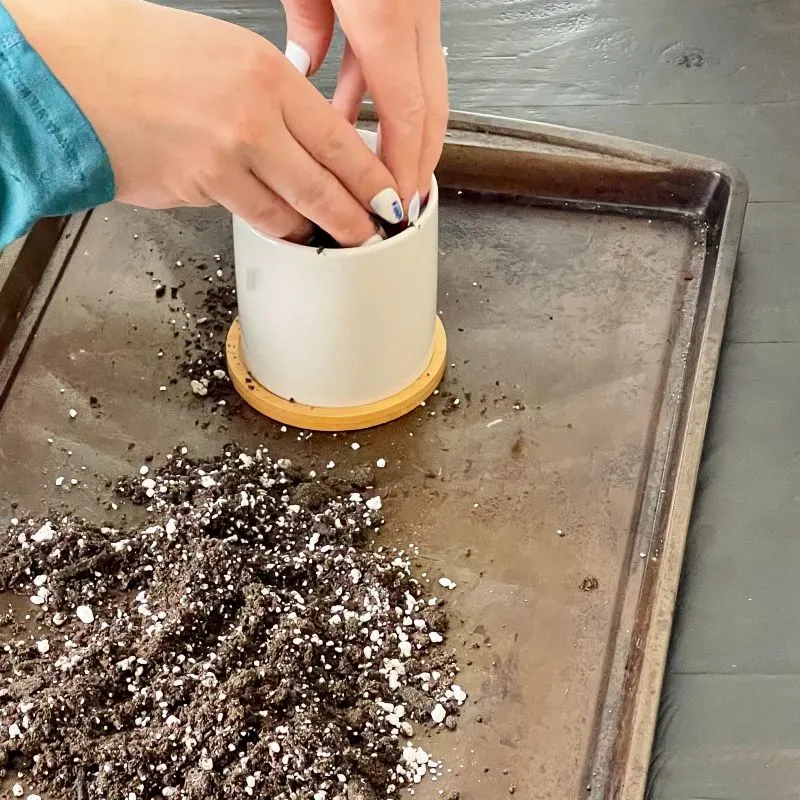
- A mix of potting soil and perlite will keep the roots happiest.
- Our mix for this plant is 70 % potting mix to 30% perlite.
- A heavy soil potting mix is not recommended for these plants.
Pot Size and Type: 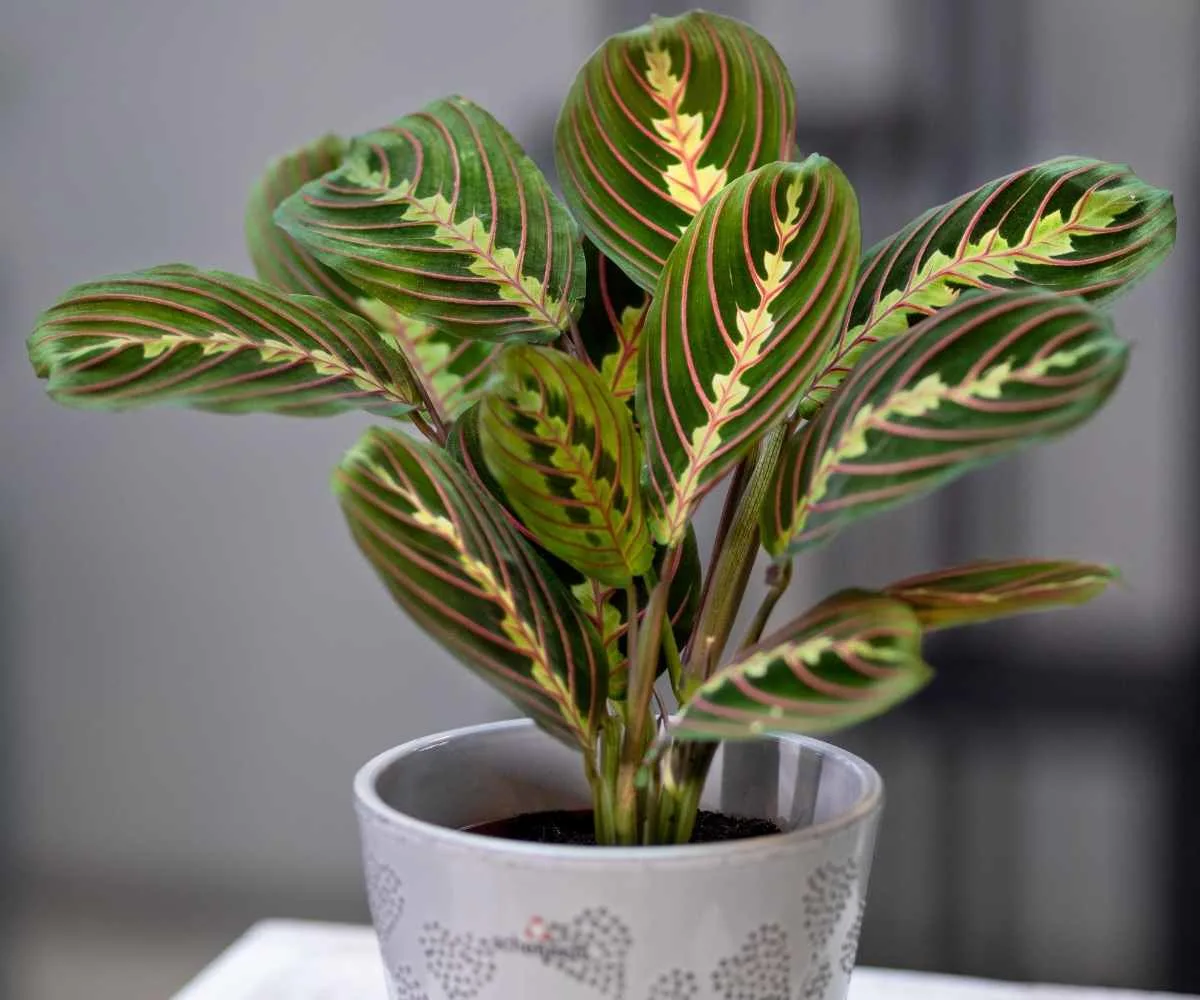
- Prayer plants grow from rhizomes. And they grow new offshoots to the sides of the mother plant.
- This means they will fill a pot out as a wider plant eventually. Quite a nice table top centerpiece.
- Some of them can trail and be used for a hanging plant as they grow.
- Maranta will grow to the size of its pot. If you leave it to grow as a grouping in one pot you will need to find a pot that is shallower and has a wider circumference. They do not like to be overly root bound.
- If you want to encourage faster growth choose a pot about 2 inches wider in diameter than the current pot.
- Any well drained pot can be used. It MUST have excellent drainage.
- Terra cotta pots are not recommended. They will wick too much water away from the soil.
- Repot every second year or when roots come out the drainage holes on the pot bottom To the next pot size up.
- Don't jump to a huge pot from a small one unless you wish to encourage faster growth. Just go to the next size up pot.
- For Maranta self watering pot systems work well. (linked above). They control the watering for you and help avoid root rot, overwatering and under watering.
- Prayer plants enjoy evenly moist soil so self watering systems help here.
Lighting:
- Maranta plants all enjoy indirect light for best leaf variegation and optimal growth.
- As a general rule if the leaves fade move to a less bright area and see if that helps. Too much light can fade the leaves and crisp the leaf edge.
- It will tolerate lower indirect light but the plant may grow more slowly. Leaf variegations may not be well expressed.
- Shield this plant from strong direct light in summer south and west sunny windows. The leaves will burn and the colors will fade. Look for dry brown spots on the leaves and curling brown edges. If you see them move the plant to lower light.
- Tip: Window sheers or blinds can offset some brief periods of high direct light.
Watering:
- Maranta are sensitive to the water you use. These are plants accustomed to soft acid water from rain forests. Hard water high in chemicals, minerals and salts may cause trouble for them.
- Let your tap water sit for 24 hours to allow any chemicals to dissipate. Filtered or distilled water will also prevent problems with minerals.
- Water your maranta when the soil is dry down an inch or so. Prayer plants enjoy even moisture in the soil. But never let it sit in soaking wet potting mix.
- If your plants leaves start to roll up and curl, the plant droops or the edges turn brown suspect watering problems.
- Under watering can show all the symptoms listed above. Adjust your watering or soil mix to accommodate.
- Over watering will end in root rot, grey mold on the leaves, algae growth on the soil and fungus gnats or other pests moving in.
- Try a watering schedule of once a week. But do not water if the soil is wet. Alternately, Do not let the soil dry out completely.
- Watering is best done on a regular schedule so the plant is not over or under watered. Both can cause stress.
- These tropical plant enjoy humidity of 40 to 60%. That's a lot.
- In dry climates this plant will thrive with a humidifier nearby. Or set it in your kitchen or bathroom. Frequent misting on a regular daily schedule will help.
- More humidity tricks: Set the plant on a pebble tray with water not touching the soil for added humidity as necessary. Grouping plants together will provide more humid conditions.
- In dormant winter months reduce watering to when the soil is dry down 2 inches .
- Never let this plant get wet feet. If the soil is compacted the bottom of the soil can remain wet which encourages, grey mold on the leaves, root rot and Fungus Gnats. If you see yellow leaves or brown curling leaf edges you are probably overwatering or Inconsistently watering.
- self watering planters are a good choice. They remove many of the watering problems listed here.
How to Fertilize:
- Marantas benefit from a regular fertilizing schedule.
- Apply a good quality fertilizer (linked in materials) monthly through Spring and summer.
- Decrease feedings by late Fall and allow your plant to rest through the winter months.
- Look for brown spots on the leaves of your plants. This may indicate an over concentration of salts in the roots from over feeding. It can burn the leaves.
- The remedy is to set the plant under a faucet of water and let the water run through for 10 minutes or so. Allow the pot to Completely drain. Discontinue fertilizer until the plant recovers.
Temperature:
- Optimal temperatures for prayer plants are 65 degrees F. to 75 degrees F.
- Marantas are sensitive to cold drafts from windows and doors.
- In winter, beware heat vents blowing on your plant leaves. They cannot tolerate uneven heating, or drying heat vents or drafts.
Pruning and Training:
- Sharp Hand pruners are preferred for pruning. They will give a clean cut that will heal quickly.
- Cut off the leaves at the soil line.
- Pruning is usually done to shape the plant or keep it small.
- Marantas grow wider rather than taller. This makes them ideal table top or window sill plants.
- If you leave a maranta unpruned it may become a trailing plant. They make interesting and attractive hanging baskets and look great trailing off a table or shelf.
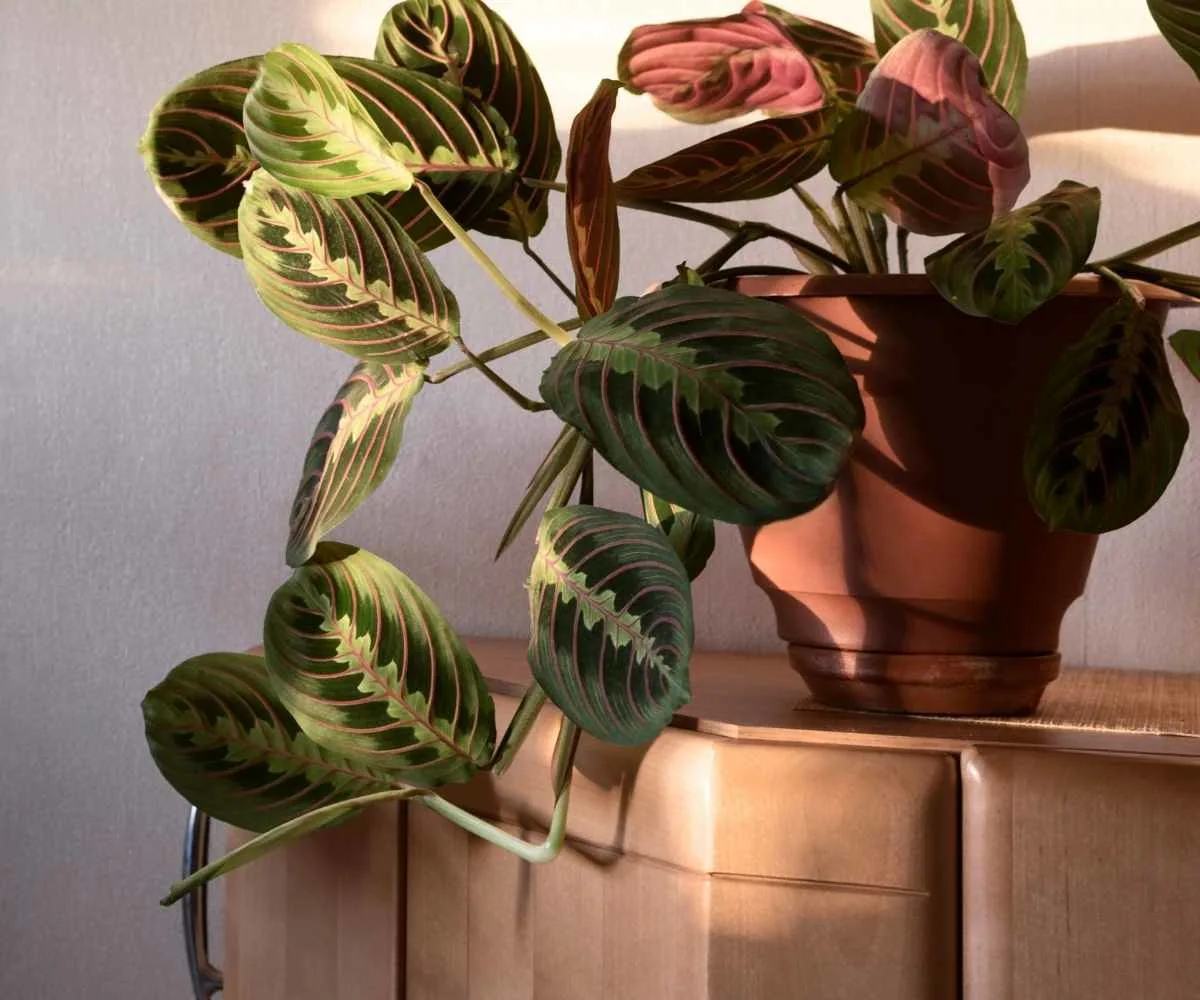
Leaf Care:
- For the best care leaves enjoy occasional washing.
- This helps keep the stomata (leaf pores) open for plant respiration.
- Healthy leaves with a good clean surface are most able to resist pests.
- Dusty leaves will starve the plants of water exchange through humidity.
- Hand Wash the leaves monthly with water.
- You can also use a shower to clean off a maranta. Beware the water temperature. Keep it room temperature to avoid shocking the plant.
Pests:
- All plants get attacked by pests. ]Marantas are especially susceptible to spider mites.
- Stress by longterm poor watering practices, poor light, extreme temperatures and soil conditions are contributors to pests. Fungus gnats will set up house in the soggy soil of an overwatered plant.
- Washing the plant leaves occasionally will help keep pests from establishing themselves on the plant.
- Spider mites are the biggest problem for prayer plants. Watch for the webs. Treat immediately and continue for two weeks or more to remove the next generation of spider mites after the adults die. Eggs attach to the leaves and cannot be washed off easily.
- Mealy bugs, scale, thrips and whitefly are also common houseplant pests you will see in a stressed plant.
- Read our post on How to get rid of aphids and other pests with our homemade pesticide soap recipe or neems oil.
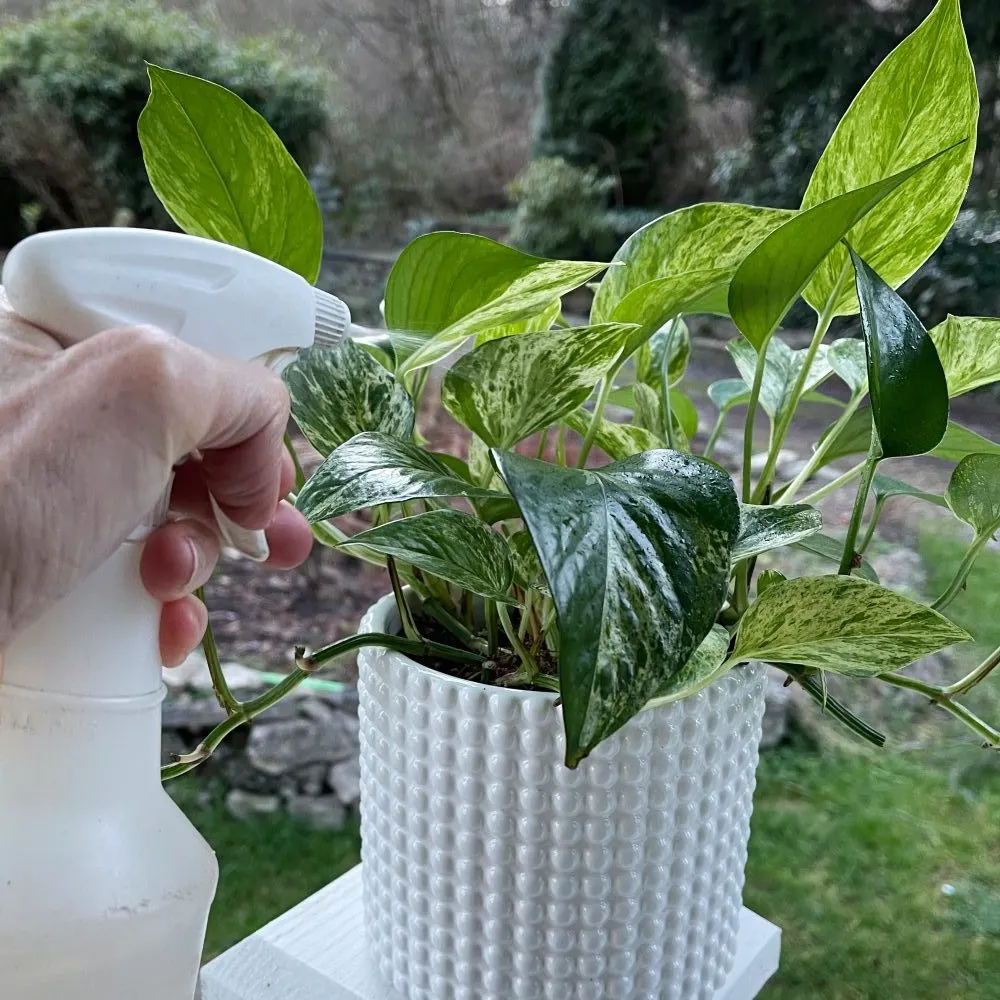
- To minimize the possibility of pests be sure to check all nursery plants before bringing them home. Carefully examine the top and bottom of the leaves.
- Do NOT purchase plants with signs of pest damage or disease.
- Quarantine all new plants until you are sure no pests live in them.
How to Propagate Calatheas:
Root Division:
- Propagation is easiest through root division.
- Seed propagation can be done but the seeds can be difficult to source.
- Dividing a Maranta is easiest when repotting it in spring or summer.
- Unpot the plant gently. Look at the root system. If the plant is mature you should see a natural parting in the leaves and roots. This is the two plants growing together.
- Gently pull the two parts to separate them. If the roots are heavily intertwined cut them as necessary with sharp sterile scissors or small pruners.
Pot the two plant sections in separate pots. In 2 to 4 weeks the divisions should be settled and growing.
Stem Cuttings:
SOIL:
- Cut the stem below the leaf node above the soil line.
- Dip it in rooting gel for a quicker rooting.
- Plant the stem in moist soil.
- Keep the soil moist until you see new signs of leaf growth. This can take up to 8 weeks.
WATER:
- You may set the stem cutting into a jar of filtered water rather than planting it in soil to root.
- Change out the water every other day.
- It will take 4 to 6 weeks to grow a root.
- Plant in soil when rooting in an inch long.
Non Toxic Plant:
- All prayer plants are non toxic to humans and pets. Still it not recommended to chew any houseplant.
- Biting or swatting are not good for the health of the plant.
- Also you don't know what chemicals or pathogens are in the soil or fertilizers you use. So best practice is to keep houseplants away from pets and kids.
Follow Us:
Find us on YouTube, Instagram , Pinterest and TikTok! We love to Plant chat. We also comment, like and occasionally share your content to our daily stories. We’d love to see your plants. Share your joy in your houseplants. Happy Planting!
More Houseplants:
We have so many wonderful houseplants on this blog. Here’s a few we think you will like. Be sure to search for them all in our houseplant section.
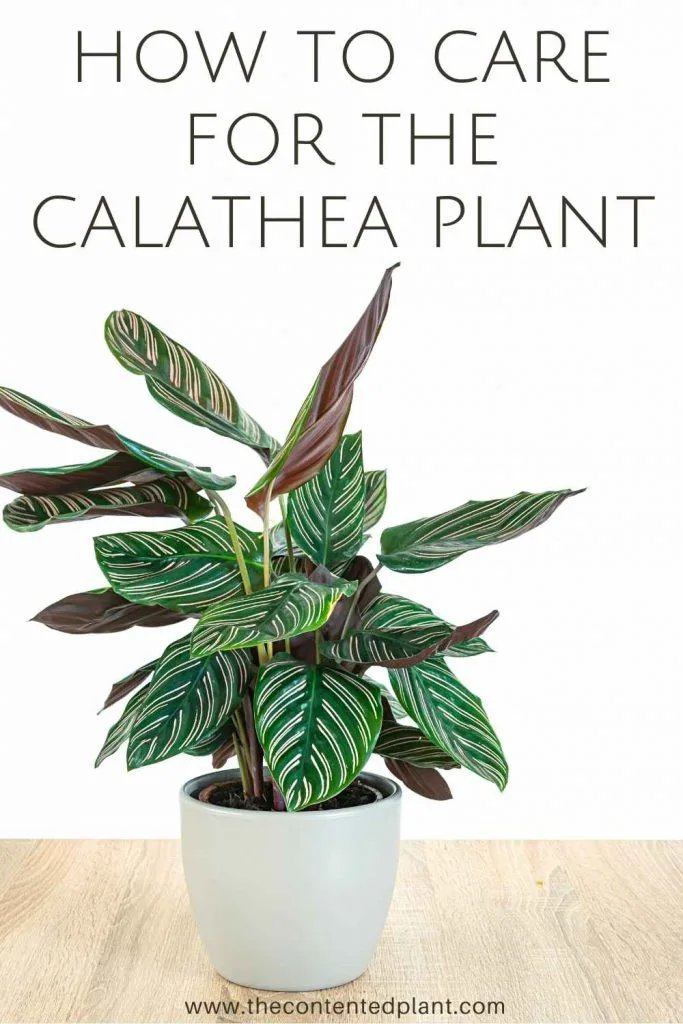
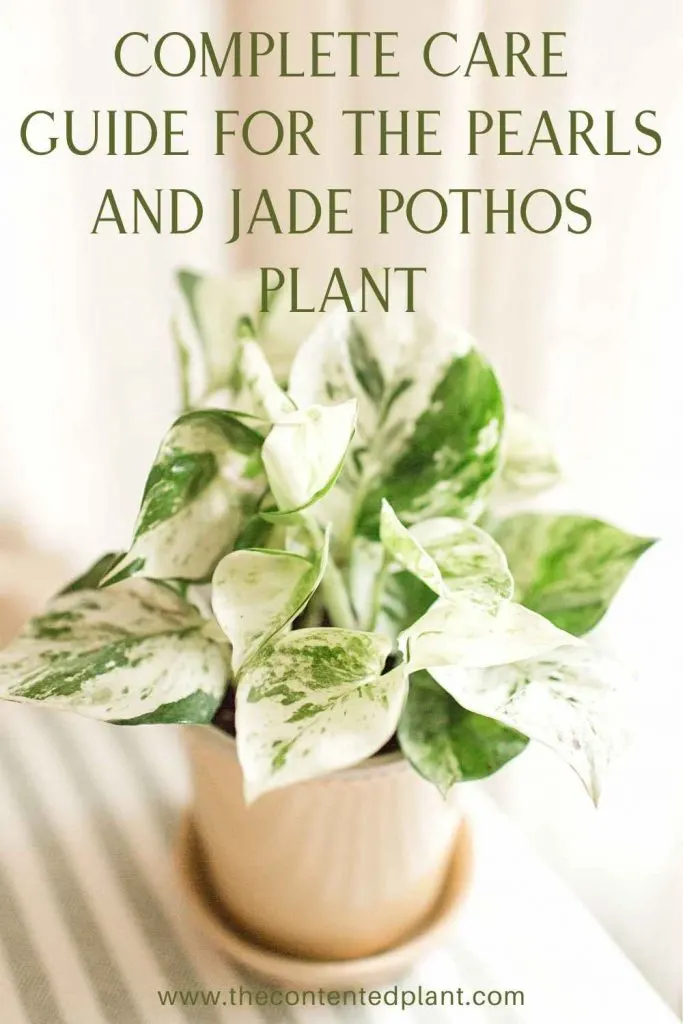
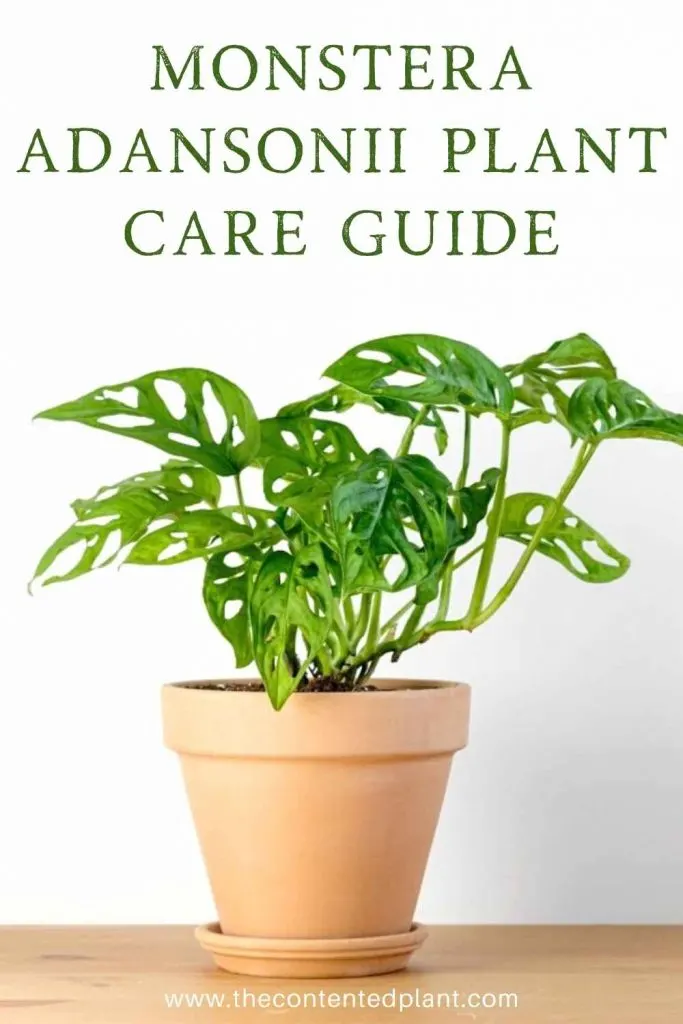


Calathea Ornata Care guide and Plant Profile - The Contented Plant
Sunday 8th of August 2021
[…] included in the Marantaceae plant family along with arrowroot. They are related to the well known Marantas. And are often confused as praying hands […]